MLB History: The all-time workhorses for each team

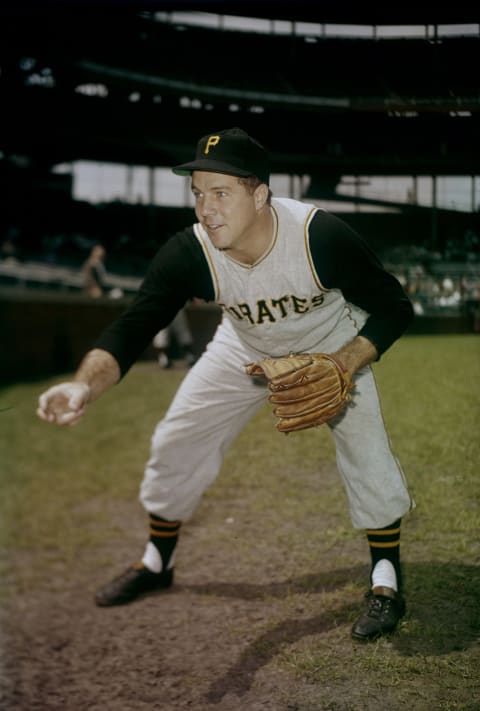
Let us take a look back through MLB history at the all-time workhorses for each team.
The death of former Pittsburgh pitcher Bob Friend a few years ago brought to light Friend’s generally forgotten distinction: He pitched more innings for the Pirates than any pitcher in the franchise’s history.
In Friend’s case, that encompassed 3,480.1 innings over 15 seasons. That was nearly 280 more than the previous Pirate standard-bearer, Wilbur Cooper, whose mark he eclipsed in 1964. Since then, the closest any Pirate has come to matching Friend’s total was the 2,672 innings amassed by Friend’s long-time teammate, Vernon Law, when he retired after 16 seasons in 1967.
Friend also remains the franchise leader in several other categories, including strikeouts (1,682) and starts (477).
With the recent losses of Gerrit Cole and Tyler Glasnow, the current Pirates really have nobody with enough experience to project a possibility of some day catching Friend.
Do you know which pitcher leads your favorite team in all-time innings pitched? It’s not always the obvious answer. Keep in mind that pitchers in days of yore tended to stay in games longer than is today the practice.
Still six franchise-leading pitchers were primarily active with their teams during the 21st Century. Of course that’s generally because their teams were created late in the 20th Century. Only two recent pitchers lead a team whose history dates back farther than 1992.
That doesn’t mean, however, that the roster of most active pitchers is a list of names from your great-granddad’s era. A dozen primarily pitched following the first expansions of 1961-62. The careers of four other leaders, Friend among them, essentially bisected the first expansions.
All-time leaders of the remaining eight teams do go back to the days of eight-team leagues.
Presented in order of the number of their franchise-leading innings pitched, here are the 29 pitchers who share with Friend the distinction of being a team-leader in workload. You can test your own knowledge of both franchise and MLB history, because in the introduction to each team three options are presented, only one of whom is the actual leader.
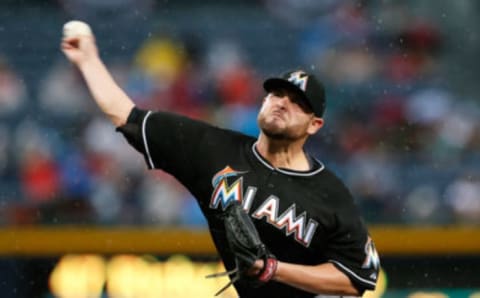
Miami Marlins all-time workhorse: Ricky Nolasco
1,225.2 innings
The Marlins acquired Nolasco, then a minor leaguer, in a December 2005 trade that sent Juan Pierre to the Cubs. Thrust immediately into the rotation, he made 22 starts in 2006, going 11-11. He led the team in victories in 2008 (15), and again in 2010 (14).
Nolasco first led the Marlins in innings pitched in 2008, when he threw 212.1. He repeated that distinction in 2011 with 206. But in 2013, with Nolasco having won just five of his 18 starts and Miami going nowhere, the Marlins traded him to the Dodgers for three prospects.
Nolasco left with a career 81-72 record, and today he retains those Marlins team records as well as his workload record. The latter, by the way, is about 200 more than the current runner-up, Dontrelle Willis.
Nolasco also leads in strikeouts, with 1,001, and starts, with 197.
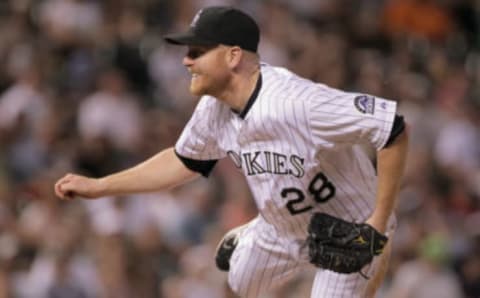
Colorado Rockies all-time workhorse: Aaron Cook
1,312.1 innings
A second-round Rockies draftee in 1997, he debuted in 2002 with five starts and four relief appearances. He split time between the rotation and bullpen in 2003 before settling into a permanent starting spot in 2004.
Between 2006 and 2011, Cook averaged 26 starts for Colorado. Over 10 seasons in Denver, he compiled a 72-68 record before being signed as a free agent by Boston prior to the 2012 season. He pitched one unsuccessful season there, and retired the following winter.
Cook twice topped 200 innings, with 212.s in 2006 and 211 in 2008. He won a career-best 16 games that summer, losing just 9, and recording a 3.96 ERA in 32 starts.
Beyond leading in innings pitched, Cook also leads all Rockies in starts with 206 and losses with 68. However, his 72 victories rank only second, 14 behind Jorge De La Rosa.
How safe is Cook’s 1,312.1 inning standard? In theory, several presently active pitchers could do it. The problem in every case is that they’re either pitching for another team or unemployed.
That list includes former Rockies Jorge De La Rosa (who, at age 37 and unsigned for 2019, trails Cook by 170 innings), Ubaldo Jimenez, also available at age 35, 851 innings short, Jhoulys Chacin, under contract with Milwaukee, 640 innings short, and Tyler Chatwood, under contract with Chicago, 806 innings behind Cook.
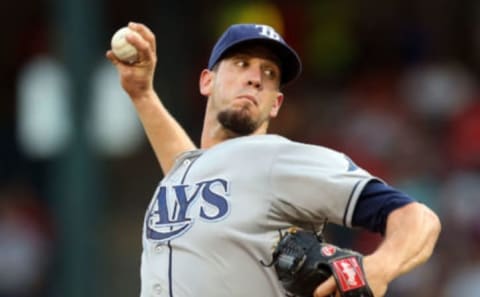
Tampa Bay Rays all-time workhorse: James Shields
1.454.2 innings
The Devil Rays drafted Shields in the 16th round in 2000. Following a lengthy minor league apprenticeship, he debuted in 2006, starting 21 games as a rookie and going 6-8.
The Rays weren’t very good in 2006 – they finished last as usual in the AL East — but they were improving, and Shields was one of the reasons. In 2008 they made a 30-game improvement in the standings, and Shields was the staff ace. He pitched a team-high 215 innings, won 14 games against 8 losses, and made 33 starts plus four more in the post-season, one of them Tampa Bay’s only victory in a five-game World Series defeat at the hands of the Phillies.
Between 2007 and 2012, Shields never worked fewer than 203 innings for the Rays, running up an 87-73 record and 3.89 ERA with the team. He helped them to post-season appearances in 2010 and 2011.
Following the 2012 season, however, the Rays traded Shields and Wade Davis to the Kansas City Royals for three prospects, all of whom remain in the majors: Wil Myers, Mike Montgomery and Jake Odorizzi.
He remains the franchise leader in both victories and losses as well as strikeouts (1,250).
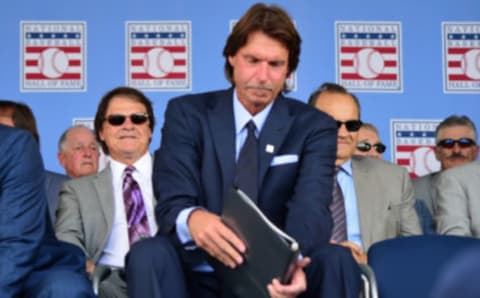
Arizona Diamondbacks all-time workhorse: Randy Johnson
1,630.1 innings
Given that Johnson was an established figure in MLB history before ever arriving in Arizona at age 35, his status as the franchise’s all-time innings-eater probably says more about the state of D-Backs pitching than it does about Johnson.
Still it would be a mistake to overlook the eight workmanlike seasons he gave the desert team, starting with his arrival via free agency following the team’s inaugural season in December of 1998.
In 1999, Johnson went 17-9 in a league-leading 271.2 innings as Arizona won the National League pennant in only its second season. For that achievement, he won the first of four consecutive Cy Young Awards.
The second came a year later when Johnson went 19-7 in 248.2 innings. In 2001, as Arizona beat New York in the World Series, Johnson pitched 249.2 regular-season innings with a 21-6 record. In 2002, he lead the league a second time with 260 innings and a 24-5 record for his fourth straight Cy Young.
In those four seasons alone, Johnson compiled more than 1,000 innings on the mound for Arizona.
Following the 2004 season Arizona traded Johnson to the Yankees, but he was traded back to Arizona two winters later, padding his innings total by nearly 250 before signing as a free agent with San Francisco for his final 2009 season.
The closest threat to Johnson’s franchise record evaporated when Patrick Corbin signed as a free agent with the Washington Nationals this past winter. He stands third behind Johnson and Webb with 945.2 innings.
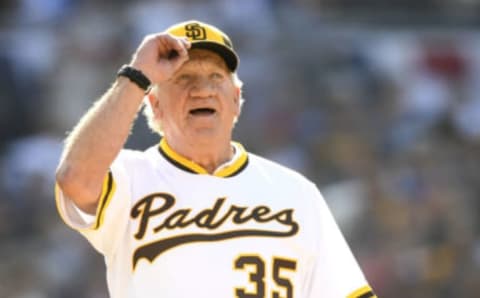
San Diego Padres all-time workhorse: Randy Jones
1,766 innings
The Padres drafted Jones out of Chapman University in the fifth round in 1972 and he debuted one year later. By 1974 he was a rotation anchor, making 34 starts and pitching 208.1 innings. The Padres, however, lost 102 games, partially explaining Jones’ 8-22 record.
He blossomed in 1975. Starting 36 times, he pitched 285 innings, compiling a 20-12 record and league-leading 2.24 ERA. In 1976, Jones led the National League with a 315.1 inning workload in 40 starts – 25 of them complete games. He also started – and was named winning pitcher in – that summer’s All-Star game. All that plus his 22-14 record and 2.74 ERA won him the Cy Young Award
Jones never dominated in the same fashion again, although he still carried more than his fair share of the workload. He topped 250 innings in both 1978 and 1979. Following the 1980 season, however, the Padres traded Jones to the Mets for a pair of prospects. He was released in 1982, signed by the Pirates prior to the 1983 season but released during spring training, and retired.
Jones went 92-105 in his 8 seasons with the Padres. Since his departure, several pitchers have made a run at his innings total, but none has come closer than Eric Show’s 1,603.1, still 163 innings short of Jones.
No current Padre has pitched more than 400 innings in a San Diego uniform, so assessing any of their chances would be the rawest form of speculation.
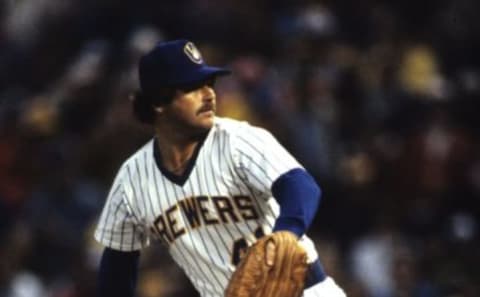
Milwaukee Brewers all-time workhorse: Jim Slaton
2,025.1 innings
Drafted by the expansion Seattle Pilots – who became the Brewers – in 1969, Slaton made the majors in 1971, impressing with a 10-8 record in 23 starts. That did not, however, prevent the Brewers from sending him back to Evansville for most of 1972.
He arrived to stay in 1973, starting 38 times and working 276.1 innings on his way to a 13-15 record. Annually through 1979, Slaton completed at least 200 innings, almost all of them for the Brewers – although he did spend 1978 with the Detroit Tigers. He was traded the previous December for outfielder Ben Oglivie, but he re-signed with Milwaukee as a free agent for 1979.
Slaton’s second stint with the Brewers lasted five seasons, including the 1982 American League pennant-winning campaign. He went 10-6 working mostly in relief, but still getting in 117 innings. Operating mostly as a finisher in 1983, he added 112 innings and five saves atop a 14-6 record.
Following the 1983 season, the Brewers traded Slaton a second time, this time the California Angels.
In the 35 seasons since Slaton’s departure no Brewer has come within 400 innings of his total, Mike Caldwell – at 1,604.2 – approaching the closest. Within the past decade, only Yovani Gallardo – with 1,289 – has come within 1,000 innings of Slaton.
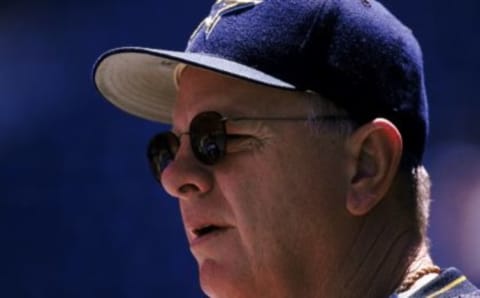
Houston Astros all-time workhorse: Larry Dierker
2,294.1 innings
Signed by the Houston Colt 45s as a 17-year-old amateur free agent in 1964 — the days before either the draft or the Astros – Dierker made three quick appearances that same season and arrived to stay as an 18-year-old one season later. In 19 starts and seven relief appearances, he went 7-8 but saw 146 innings of work.
The experience solidified Dierker’s role as a mound leader in Houston. In 1966, still not yet 20, he went 10-8 in 28 starts. He topped 200 innings for the first time in 1968, and worked 305 in 1969 with a 20-13 record in 37 stats, 20 of them complete games. Not surprisingly, he was named to the All-Star team for the first of two times.
It was Dierker’s only 20-victory season, but not his last experience as an Astro mainstay. With the exception of one season when medical issues sidelined him, he started at least 23 games and pitched at least 159 innings annually through 1976, compiling a 139-123 record with Houston.
Although a 13-season veteran and not yet 30, Dierker had nearly 2,300 innings under his belt, so prior to the 1977 season the Astros traded him to St. Louis. Lightly used there, he retired at season’s end.
A few years later, former teammate Joe Niekro nearly took down Dierker’s record. But in 1985 the Astros traded Niekro to the Yankees when he was 25 innings short of Dierker’s franchise mark. Although Niekro had nearly 300 more major league-quality innings in his arm, he pitched none of those innings for the Astros.
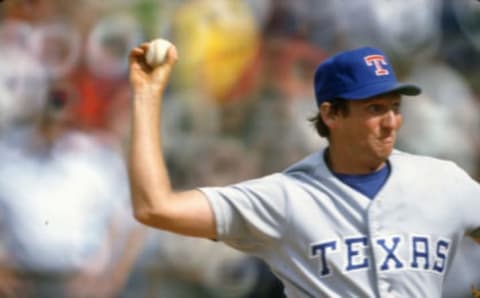
Texas Rangers all-time workhorse: Charlie Hough
2,308 innings
Like Randy Johnson in Arizona, Hough arrived late at his destination; he was 32 when the Rangers purchased him from the Los Angeles Dodgers in July of 1980. Normally there is not much future in a 32-year-old reject, but Hugh’s knuckleball made him immune to age-related concerns.
Instead, he pitched 11 seasons in Texas, twice leading the league in starts and once in innings pitched. He made 313 starts in Texas, and produced a 139-123 record with a 3.68 ERA.
Between 1982 and 1990, Hough was a consistent double-figure winner, five times topping 250 innings and peaking at a league-leading 285.1 in 1987. He started 40 games that season, going 18-13 and in the process blowing by Ferguson Jenkins’ franchise record of 1,410 innings.
Since then, Kenny Rogers has come the closest to Hugh, but even Rogers stopped 400 innings short. Nolan Ryan is closely affiliated with the franchise, but at 840 innings he ranks only 15th all-time in workload.
Among Rangers of a more recent vintage, the closest has been Yu Darvish, who compiled 782.2 innings in a Texas uniform before being traded to the Dodgers in mid-season 2017.
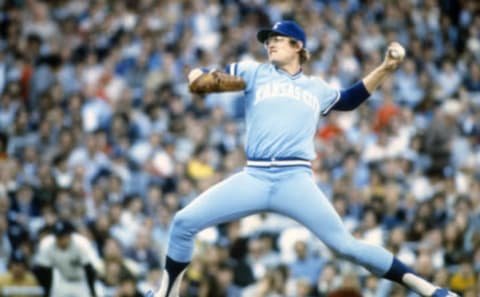
Kansas City Royals all-time workhorse: Paul Splittorff
2,554.2 innings
Drafted by Kansas City out of Morningside College before the team had played a single game in 1968, Splittorff got a brief callup at the end of 1970, and established himself in 1971. In 1972, at age 25, he started 33 games and worked 216 innings, all of that leading to a 12-12 record.
Splittorff pitched his entire 15-season career in a Royals uniform, one obvious reason why he was a lifetime favorite with the team’s fan base. In seven different seasons he exceeded 200 innings, compiling a lifetime 166-143 record and 3.81 ERA.
His 2-0 post-season record belies his team’s recurrent fall failures. He pitched in the 1976, 1977 and 1978 ALCS, and Kansas City lost all three of those series. Splittorff also saw relief action in the 1980 World Series against Philadelphia, another Royals defeat. Ironically, he retired in 1984; one season later the Royals won the World Series.
A teammate, Mark Gubicza, made the strongest run at Splittorff’s team record for workload. But a trade to the Angels late in Gubicza’s career negated any slim chance that he might compile the 336 innings he needed . Instead, Gubicza went 0-1 in 5 innings for the Angels in 1997 and called it quits.
Since then the closest challenger has been Zach Greinke, who pitched 1,108 innings before the Royals concluded he had more trade value than on-field value. Danny Duffy, the closest current Royal, has 1111.1 innings, ranking 10th in team history.
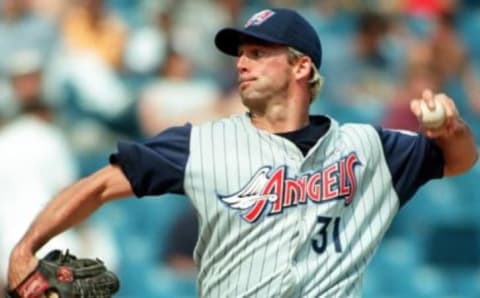
California/LA Angels all-time workhorse: Chuck Finley
2,675 innings
Due to their visibility, Ryan and Lackey both sound like more likely choices to top the Angels list. Finely was a less dynamic presence, so he’s easy to overlook.
The facts are that he pitched for 14 seasons in an Angels uniform, going 165-140.
The Angels drafted Finley in the 15th round in 1984, and when he refused to sign they drafted him again, this time with the fourth overall pick in 1985. Called up in May of 1986, he established himself as a rotation fixture in 1988, making 31 starts and pitching 194.1 innings.
For the next decade, Finley led the Angels’ rotation. Between 1988 and 1999 he averaged 31 starts and 211 innings, never making fewer than 25 starts. He pitched a league-leading 13 complete games in 1993, and during the strike-shortened 1994 season led in innings at 183.1. He passed Nolan Ryan as the franchise leader in innings in 1994.
Can any Angel catch Finley? At 2,025, Jered Weaver has made the strongest recent run, although that still left Weaver 650 innings short. Garrett Richards, who ranks 21st all-time at 744.2, was a contender until injuries slowed his development; he has since signed elsewhere.
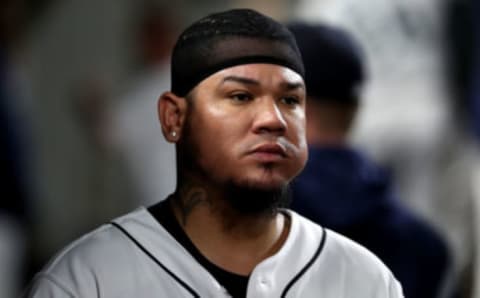
Seattle Mariners all-time workhorse: Felix Hernandez
2,729.2 innings
The Mariners signed him as an amateur free agent in 2002. Hernandez was just 16 at the time. He debuted three years later, going 4-4 in a dozen starts. In 2006, still just 20, he got 31 starts and went 12-14 in a team-leading 191 innings.
That quickly became a Hernandez trademark. He led Seattle in starts and in innings pitched in 2008, 2009, 2010, 2011, 2012, 2014, 2015 and 2016. Between 2008 and 2015 he never failed to compile at lest 200 innings, rising to a league-leading 249.2 innings in 2010. He led the American League – for the first of two times – in ERA that season at 2.27.
Hernandez’ pace has slowed since 2015 as age and ineffectiveness combine to take a toll. Still, he is only 33 and remains in the rotation, so the question is how high he can run up his franchise lead. He already leads Moyer by nearly 600 innings.
The two pitchers who had the best chance to some day catch Hernandez both recently left the Mariners. James Paxton, 20th on the list at 582.1 innings, was traded to the Yankees. Hisashi Iwakuma, who ranks 12th at 883.2, went unsigned as a free agent following 2017 arm surgery.
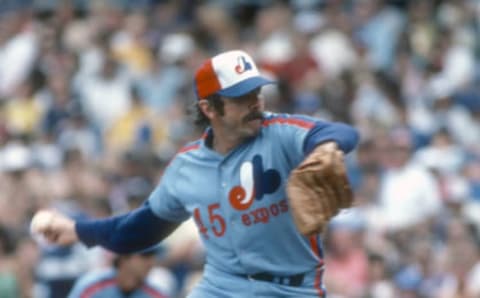
Montreal Expos/Washington Nationals all-time workhorse: Steve Rogers
2,837.2 innings
Drafted by the Expos out of the University of Tulsa as the fourth overall pick in 1971, Rogers debuted in mid-season 1973 and spent his entire 13-season career up north. He was an immediate hit, finishing second in Rookie of the Year voting with a 10-5 record in 134 innings.
Rogers made five All-Star teams, his first coming in 1974 when he led the Expos with 253.2 innings of work in 38 starts. In some seasons, he was all Montreal had. In 1975, he pitched 251.2 innings in 35 starts, totals that were 81 and 8 ahead of the team runners-up. In 1977 he made 15 more starts than any teammate and accumulated 116 more innings, topping the 300 inning mark.
He was the ace of the 1981 Expos staff that lost the NLCS to Los Angeles in heart-breaking fashion, and Rogers was in his customary position on the scene for the fall. Working in relief, it was Rogers who served up Rick Monday’s series-winning home run in the decisive 2-1 Dodger victory in the ninth inning of game 5.
Rogers called it quits in May of 1985 with a 158-152 record and 3.17 ERA, all of it for Montreal.
Since then, nobody has approached his innings total, Dennis Martinez coming closest but falling more than 1,000 innings short.
If the current Nats have anybody capable of approaching Rogers’ total, it’s probably Stephen Strasburg, although his fragile workload makes even that hard to imagine. Entering 2021, Strasburg stands third on the franchise list with 1443.2 IP but a daunting 1,394 behind Rogers. To catch Rogers, then, Strasburg would have to average 200 innings with the Nats for more than seven seasons.
Since Strasburg is 32, the age puts him on the fence in that race. His workload is another question. During the five seasons prior to the COVID-19 shortened 2020 season, Strasburg only averaged 159 innings and only topped 175 innings once. At an average of 160 innings per season, Strasburg would have to remain with the Nationals another nine years to approach Rogers.
That’s probably OK with Nationals’ fans; whether it’s OK with Strasburg’s agent is yet to be determined.
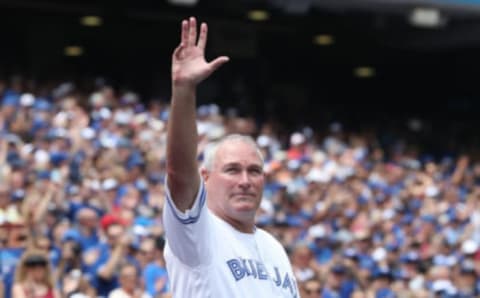
Toronto Blue Jays all-time workhorse: Dave Stieb
2,873 innings
A fifth-round draftee in 1978, Stieb arrived in June of 1979 and immediately was installed as a rotation fixture. The Jays were in only their third season of existence then and had no higher purpose than the development of promising pitching.
That fit Stieb perfectly. In 1980 he started 32 games, pitched 242.2 innings and went 12-15, making his first of seven All-Star teams. His profile rising with the team’s success, he topped 265 innings annually between 1982 and 1984, and in 1985 led the Jays to their first divisional title with a league-leading 2.48 ERA. In that year’s ALCS, he started three times against the Royals, winning game 1, taking a no-decision in a Game 4 Toronto victory, but losing the decisive seventh game 6-2.
Stieb made two other career post-season starts, both losses in the 1989 ALCS against Oakland. Granted free agency following the 1992 season, he signed with the Chicago White Sox but pitched only briefly before being released and trying for several seasons to catch on with some other team. Following a four-season hiatus, that team turned out to be the Jays, for whom he made 19 appearances in 1998, when he was 40.
The 50 innings he worked ran his Toronto total to its present level.
For a time, Roy Halladay had a plausible chance to pass Stieb, but stopped at 2,046, more than 800 innings short. The closest current Jay is Marcus Stroman, who ranks 19th on the all-time list at 665. That’s 2,200 behind Stieb, meaning Stroman would have to average 200 innings over 11 seasons to catch him. Stroman is only entering his age 28 season so that idea can’t be ruled out. But following a pair of 200 inning seasons in 2016 and 2017, he managed only 102 last year.

Cincinnati Reds all-time workhorse: Eppa Rixey
2,890.2 innings
Acquired by the Reds in 1920 from the Philadelphia Phillies – where he had been second banana to Grover Cleveland Alexander – Rixey made a Hall of Fame career out of being a reliable support player.
Although rarely mentioned among the era’s great pitchers, Rixey lasted 13 seasons with the Reds, an impressive total considering that he was 30 when he arrived. He made 357 starts and ran up a 179-155 record, topping 200 innings in his first nine seasons with the team and topping 300 innings in each of his first two.
He won a league-leading 25 games in 1922, added 20 more one season later and 21 in 1925. Rixey was durable enough to handle a 291.1 inning workload in 1928, when he was 37. He retired following the 1933 season.
The Reds have never been known for overpowering pitching. In a way, that makes Rixey the prototype of a typical Reds ace: just good enough to give Cincy’s big bats a chance. A long-time and better-known 1920s teammate, Dolf Luque, ranks second on the career list with 1,268.2 innings.
Among pitchers of recent vintage, there are no true comps. Tom Browning managed 1,911 innings mostly in the 1990s, and Bronson Arroyo got to 1,761 in an injury-plagued career. Before departing for parts west a few seasons ago, Johnny Cueto pitched 1,339 innings for Cincinnati.
The current – and very young – Reds pitching staff features nobody with 2,000 innings of Rixey’s record, so while a talented arm such as Luis Castillo might theoretically a decade from now thrust himself into the running for the franchise top spot, that event is too far in the future to speculate on.
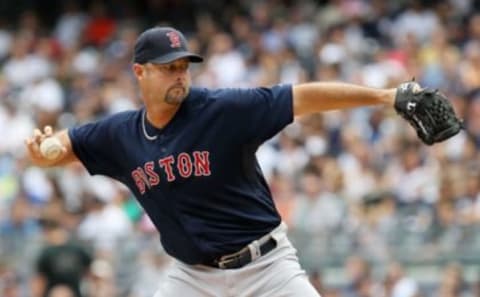
Boston Red Sox all-time workhorse: Tim Wakefield
3,006 innings
Oh, the wonders of the knuckleball.
Yes, it is Wakefield – not Clemens, not Young and not anybody in between – who sits atop Boston’s franchise innings list. He tops Clemens by 225 innings and Young by 275.
That statistical reality could not have been imagined when the Red Sox signed Wakefield as a free agent in 1995. He had been released a year earlier by the Pirates after showing little potential in his transition from failed infield prospect to knuckleball throwing pitcher, but spent the 1994 strike season at Double-A Buffalo perfecting his approach.
In Boston, Wakefield proved an interesting rotational contrast to the fireballing Clemens. He made 27 starts that first season, going 16-8 in 195.1 innings. Red Sox management believed; through 1998 he annually averaged 30 starts and more than 200 innings.
Wakefield divided his time between the rotation and bullpen from 1999 through 2002, but returned to the rotation full-time in 2003. In 2004, he delivered a 12-10 record and 188.1 innings as Boston broke an 86-season World Series drought. He pitched 11 innings in four postseason appearances that year, but was hit hard both by the Yankees in the ALCS and by the Cardinals in the only World Series start of his career. That came in game 1 when he allowed five runs in less than four innings of an eventual 11-9 Boston victory.
Wakefield passed Clemens in 2010 and retired following the 2011 season.
The 3,000 inning total is a daunting one under modern starter usage patterns, so daunting that no pitcher since Wakefield has thrown that many. So the odds of any current Boston pitcher doing so, barring a liberalization of those usage patterns, are microscopic.
For purpose of comparison, John Lester worked 1,519 innings for the Sox – about half Wakefield’s total – before being traded away.
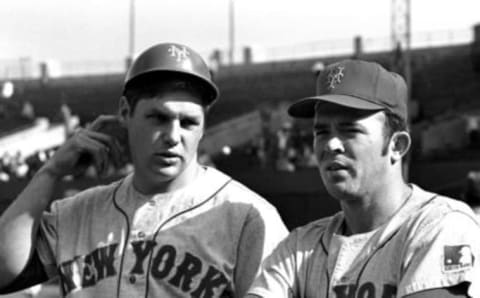
NY Mets all-time workhorse: Tom Seaver
3,045.2 innings
In company with James Shields at Tampa Bay, Seaver holds a distinction on this list. They are the only two franchise innings leaders to have been traded away at or close to the peaks of their careers.
In Seaver’s case, the trade came in mid-season of 1977 when the Mets were fading and the defending champion Cincinnati Reds needed an ace to help them haul down the surging Los Angeles Dodgers. The deal, which brought four prospects to New York, sent shock waves through the league for Seaver was only 32 and had started 7-3 with a 3.00 ERA for the Mets. He won 14 of 20 starts for the Reds, but the Dodgers still beat them out.
Seaver was signed by the Mets as an amateur free agent after a college career at USC. He fit immediately into the developing team’s rotation, going 16-13 with a 2.67 ERA in 34 starts in 1967. The baseball world, obviously, got to know him when he went 25-7 in 1969 to lead the Miracle Mets to a World Series victory over the heavily favored Baltimore Orioles.
In New York, Seaver only once delivered fewer than 250 innings. He led the National League in ERA in 1970, 1971 and 1973; won the Rookie Of the Year award in 1967; earned Cy Young awards in 1969, 1973, and 1975; and made every All-Star team except one. He was the starting pitcher in the 1970 All-Star game.
Despite his early departure, no Met since Seaver has come especially close to his innings total. Jerry Koosman is runner-up with 2,544.2, and Dwight Gooden managed 2,169.2. Among Mets of a more recent vintage, Jon Niese got to 1,079.1. Matt Harvey had 639.1 Mets innings when his career ended with a trade to Cincinnati.
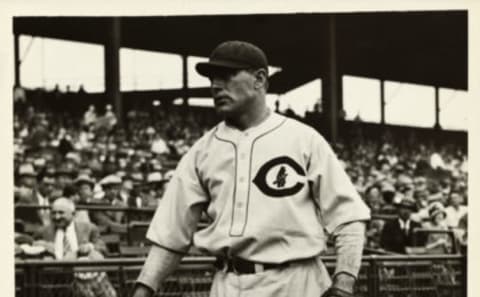
Chicago Cubs all-time workhorse: Charlie Root
3,137.1 innings
Because he was such a noted workhorse for so many seasons, Fergie Jenkins is the obvious choice as the Cubs’ innings leader. But he actually ranks only third on the franchise’s all-time list behind Root and 19th Century star Bill Hutchinson.
Root was the pitching anchor of the great Cubs teams of the 1920s and 30s. Signed in 1926 following a brief, unsuccessful stint with the St. Louis Browns, Root became an immediate mainstay. He worked 271 innings as a rookie, and followed that with a 309 inning performance in 1927 that included a 26-15 record and 3.76 ERA.
He topped 200 innings annually through 1933, then again in 1935, only twice making fewer than 30 starts or winning fewer than 15 games.
Root pitched for Chicago in the 1929, 1932, 1935 and 1938 World Serieses, although the Cubs lost all five of the games in which he appeared. Save for that handful of 1923 appearances with the Browns, he never pitched for any other team, retiring in 1941.
Since then, Jenkins has come the closest, but still trails 460 innings behind Root. Of a more recent vintage, Carlos Zambrano compiled 1,826 innings before his release. No current member of the Cubs staff is within 2,000 innings of Root, Kyle Hendricks probably having the best shot. Hendricks enters 2021 with 1047.1 innings in Chicago, so he could catch Root if he put together 12 more seasons in a Chicago uniform consisting of at least 177 innings.
While that would probably be OK with the Cubs, it sounds like asking a lot.
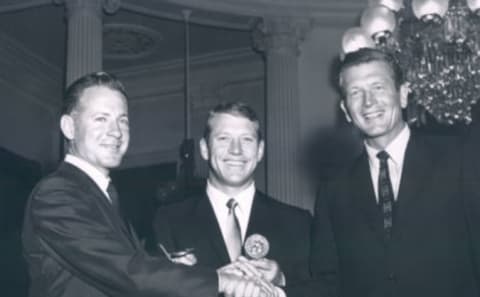
NY Yankees all-time workhorse: Whitey Ford
3,170.1 innings
Signed as an amateur free agent in 1947, Ford spent his entire 16-season career with the Yankees. His impressive innings total would be even higher but for a Korean War military commitment that cost him the 1951 and 1952 seasons.
In 1953, his first full season, he made 30 starts and went 18-6 in 207 innings. Unlike most pitchers, his most productive seasons were probably his later ones. Ford first topped 253 innings in 1961 – he was 32 at the time — when he led the league with 283 on his way to a 25-4 record. He worked 258 innings in 1962 and led the AL again in 1963 with 269.
His post-season record is legendary for its length, and to a degree for its quality. He made 22 World Series starts, producing a 10-8 record and 2.71 ERA. Between 1960 and 1962, he broke Babe Ruth’s Series record with 33.2 consecutive shutout innings of the Pirates, Reds and Giants.
Ford retired in May of 1967 with a career 236-107 record, the 1961 Cy Young Award and eight All-Star game selections. On May 12, in the second-to-last appearance of his career, he passed Rud Ruffing as the all-time Yankee innings leader. Ruffing had retired with 3,168.2 innings.
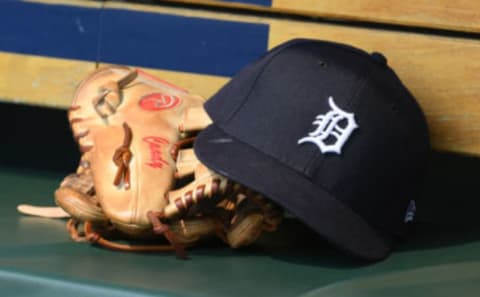
Detroit Tigers all-time workhorse: George Mullin
3,394 innings
Although barely recalled at all today, Mullin was actually the ace of the most successful string of Tigers teams in the franchise’s history. Between 1907 and 1909, he went 66-41 across 107 starts encompassing 950 innings as the Tigers swept to three straight pennants.
Signed off the sandlots during the early days of the American League, Mullin made 30 starts as a 21-year-old for the Tigers in 1902 and pitched 260 innings. He proved a glutton for work, never falling below that total until 1911.
Between 1904 and 1907, Mullin averaged 345 innings and 42 starts. In 1909 he led the AL in wins with 29. Only in 1912 did he even begin to peel back his workload, and then just to 212 innings.
Still in 1913, with Detroit’s fortunes on the wane, the Tigers sold their 32-year-old workhorse to the Senators, for whom he pitched until jumping to the Federal League in 1914.
Mullin’s numbers have stood the test of time, albeit just barely. Hooks Dauss, a long-time Tiger, retired in 1926 just four innings short of passing Mullin. In 1976 the Tigers traded away Mickey Lolich when he lacked 31 innings of catching Mullin. Jack Morris was 350 innings short when he left Detroit.
More recently, Justin Verlander had 2,511 innings in a Tiger uniform when Detroit shipped him to Houston. Had he stayed and remained uninjured, he would have been on pace to assume the all-time franchise leadership by about 2022.
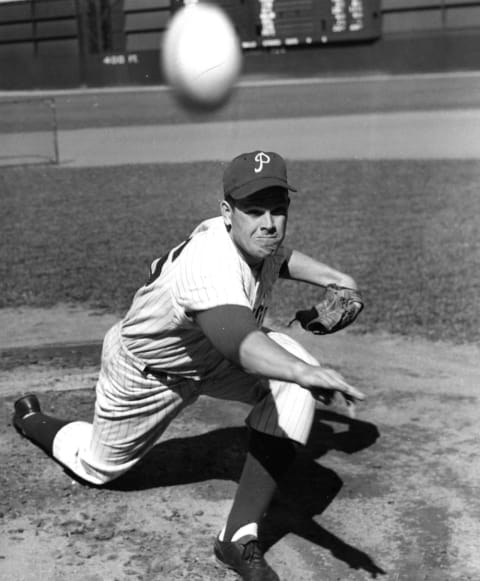
Philadelphia Phillies all-time workhorse: Robin Roberts
3,739.1 innings
Signed as an amateur free agent out of Michigan State, Roberts debuted with the Phillies in June of 1948. But his real breakthrough occurred one season later when he made 31 starts as well as a dozen relief appearances.
When the Phillies unexpectedly found themselves in a September pennant race, they worked Roberts like the proverbial rented mule. In the final 26 games, he made nine starts (three of them on two days rest and one on no rest), totaling 70 innings. The final week was typical. On Sept. 27, he pitched the first game of a doubleheader at the Polo Grounds, but was knocked out in the fourth inning of an 8-7 defeat.
The following day, he started the second game of another double-header, losing 3-1. Three days later, in the season’s final game, a winner-take-all match against the Dodgers at Ebbets Field, Roberts pitched a 4-1, 10-inning complete-game victory.
That was Robin Roberts. Between 1950 and 1955, he never pitched fewer than 305 innings, never made fewer than 37 starts, and never won fewer than 20 games. For the decade of the 1950s, he never dropped below 250 innings.
Eventually even Roberts wore down, and when he did – following the 1961 season – the Phillies sold him to the Yankees. He had long since surpassed Grover Cleveland Alexander as the franchise inning leader. In the intervening decades, the closest anyone has come to him was Steve Carlton, who was 42 innings short when the Phillies released him in June of 1986.
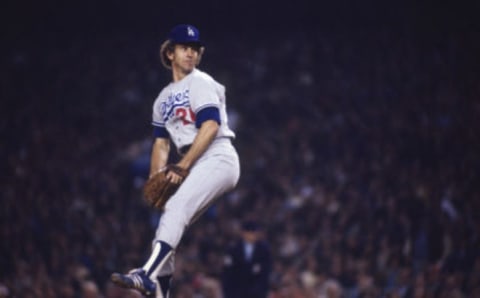
Dodgers all-time workhorse: Don Sutton
3,816.1 innings
Signed by the Dodgers out of USC as an amateur free agent in 1964, Sutton debuted in 1966 as the fourth member of the memorable rotation that also included Sandy Koufax, Don Drysdale and Claude Osteen. Although only 12-12, he was in all other aspects an instant hit, delivering a 2.99 ERAS in 226 innings across 35 starts.
When Koufax retired, to be followed a few years later by Drysdale, Sutton inherited the role as staff leader. He routinely delivered more than 250 innings, and pitched in the 1974, 1977 and 1978 World Series, compiling a 2-2 record in his six starts.
He made four All-Star teams.
When he became a free agent following the 1980 season, Sutton signed with the Astros and spent most of the rest of his career elsewhere. But in 1988 he returned briefly to the Dodgers, where he closed out his career with 16 starts at age 43, departing that August with LA clinging to a half-game lead over Houston. The Dodgers would go on to win the World Series, their most recent one before the 2020 championship.
Among present Dodgers, Clayton Kershaw stands 11th all-time with 2,333. But that’s still nearly 1,500 behind Sutton. Kershaw is entering his age 33 season, so amassing those innings isn’t physically out of the question. The problem is that Kershaw has only averaged 180 innings of work during the five years before the COVID-19 pandemic held him to 58 in 2020; at that pace he’d need to go another nine years to approach Sutton.
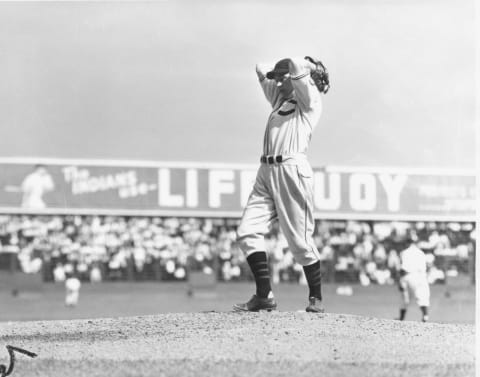
Cleveland Indians all-time workhorse: Bob Feller
3,827 innings
What kind of endurance marks might Feller have hung up if not for World War II?
The war came virtually in the midst of Feller’s career and cost him most or all of four seasons. He had averaged 300 innings in the three seasons prior to the war and he averaged 300 in the two seasons immediately following. Give him four more seasons even close to that production and he might have approached 5,000 innings with the Indians.
Feller’s story is pretty well known. Signed as a schoolboy phenom out of Van Meter, Ia., he debuted at age 17, and by 1938 – while still in his teens – was an All-Star. He led the AL in victories six times, in innings pitched five times, and in starts five times.
In 1946 he worked 371 innings, a total that has been surpassed only twice in the intervening three-quarters of a century: by Mickey Lolich in 1971 and Wilbur Wood in 1972.
Feller’s post-season career was limited and disappointing. He made just two starts, both in the 1948 World Series against the Boston Braves, losing 1-0 in game 1 and 11-5 in game 5.
Among recent Indians, Corey Kluber came closest to matching Feller’s innings count. But Kluber ranks only 21st on Cleveland’s all-time list at 1,341.2, a bit more than one-third of the way to Feller.
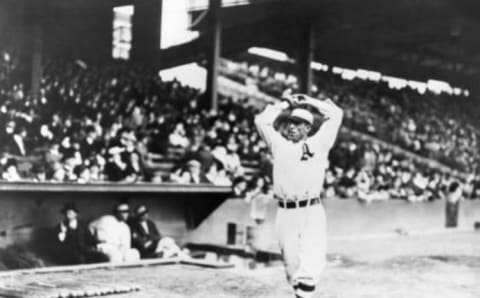
A’s all-time workhorse: Eddie Plank
3,860.2 innings
Across more than a century in time and a continent in distance, the A’s have labored to find somebody who could measure up to Eddie Plank for sheer durability. Maybe someday they’ll find such a pitcher … but not yet.
Plank arrived with the franchise in April of 1901, signing as a free agent following graduation from Gettysburg College. He was 25 and on his way to a Hall of Fame career. He pitched 260 innings that rookie season, 300 more in 1902 and 336 more in 1903. When the A’s won the 1904 and 1905 American League pennants, Plank contributed 700 innings and 50 victories to the cause.
From his rookie season through 2012, he only twice failed to work more than 250 innings, five times surpassing 300. He made seven World Series appearances, winning twice but losing 5 times despite a 1.32 Series ERA. Remarkably, four of his five defeats came via shutouts, two to Christy Mathewson. Two were by scores of 1-0, the other two 3-0.
Following one of those 1-0 World Series losses, to Boston’s Bill James in 1914, Plank jumped to the newly formed Federal League, where he finished his career. He left the Athletics with a 284-162 record and 2.39 ERA.
No other Athletics pitcher has ever gotten within 1,000 innings of Plank, so there’s not much prospect of any of the current crop doing so. Catfish Hunter had 2,456 when he was declared a free agent and signed with the Yankees in the 1970s, and Barry Zito got to 1,437 a decade or so ago.
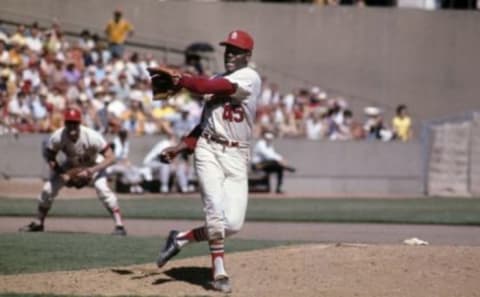
St. Louis Cardinals all-time workhorse: Bob Gibson
3,884.1 innings
Signed in 1957 out of Creighton as an amateur free agent, Gibson debuted in April of 1959 and established himself full-time in 1961. With the exception of an injury-plagued 1967 season, he topped 200 innings annually through 1972, twice surpassing 300 innings.
Gibson was famously at his best in the big moments, and especially in post-season play. He made 9 World Series starts, going 7-2 and completing all but one of them. He was the game 7 winner over the Yankees in 1964, and again over the Red Sox in 1967. In the seventh game of the 1968 World Series, he lost a complete-game 4-1 decision to the Detroit Tigers when Mickey Lolich out-pitched him.
Gibson won the Cy Young Award in 1968 – when he was also named Most Valuable Player — and again in 1970.
Gibson’s closest current challenger is Adam Wainwright, who ranks sixth all-time at 2169.1 innings entering the 2021 season. But that leaves Wainwright only about halfway to Gibson’s total, and since he will be 39 this year there is no prospect of Wainwright approaching Gibson.
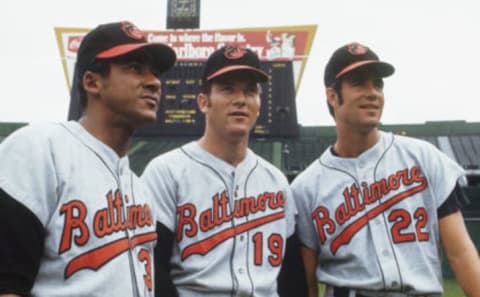
Baltimore Orioles all-time workhorse: Jim Palmer
3,948 innings
Signed in 1963 as an amateur free agent, Palmer made 27 appearances, most of them in relief, in 1965. One year later he was a key part of Baltimore’s youthful rotation that swept the team to a World Series sweep of the Dodgers. He made 30 starts, pitched 208 innings and won one of those World Series games in a shutout.
That performance thrust Palmer to the forefront of an Orioles staff that would soon dominate. When the Orioles won three straight pennants from 1969 through 1971, Palmer pitched 760 innings, winning 56 games. In four different seasons he surpassed 300 innings, doing it successively from 1975 through 1977. He also led the AL in victories all three seasons.
He won three Cy Young Awards – in 1973, 1975 and 1976 – and was named to six All-Star team. Palmer retired following the 1984 season.
Palmer’s Oriole record has basically gone unchallenged. Mike Mussina compiled 2,009 innings prior to leaving as a free agent.
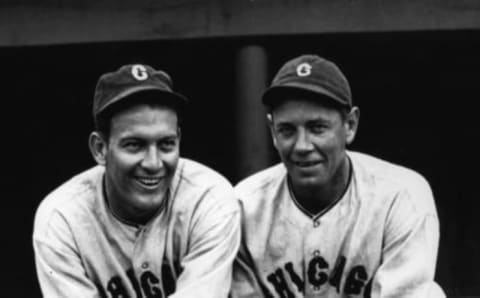
Chicago White Sox all-time workhorse: Ted Lyons
4,161 innings
Lyons signed with the White Sox due to a geographical fluke. In those days the Sox trained in Seguin, Texas, not far from the Waco campus of Baylor University where Lyons was the team’s star pitcher. Invited in the spring of 1923 to throw a sideline session to Sox catcher Ray Schalk, Lyons impressed enough to be offered a contract; he signed and debuted that July.
Lyons’ strength was durability. He pitched 21 seasons, twice leading the league in both complete games and workload. Between 1925 and 1930 he averaged 33 starts and 275 innings, topping out at 307.2 innings in 1927. There is irony in that workload given that when Lyons is remembered today, it is as Chicago’s “Sunday pitcher,” a name he was given due to his once-a-week schedule. But that lighter schedule only really took hold in the mid-1930s, when Lyons was already two-thirds of the way into his career.
Despite the fact that Lyons’ White Sox only finished in the first division five times between 1923 and 1942, he still managed to put together a career 260-230 record, prompting his Hall of Fame election in 1955.
He surpassed Red Faber as the franchise innings leader in 1941, missed three seasons due to service in World War II when he was already in his 40s, then pitched briefly for the Sox at age 45 in 1946 before retiring.
In recent seasons, the closest challenge to Lyons came from Mark Buehrle, who reached 2,476.2 innings before leaving town as a free agent.
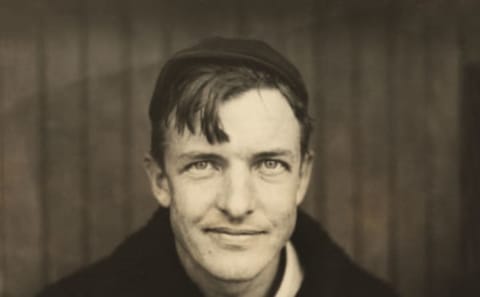
NY/SF Giants all-time workhorse: Christy Mathewson
4,779.2 innings
Historically, the Giants probably have the strongest rotation in history, featuring Mathewson, Carl Hubbell, Juan Marichal, Madison Bumgarner and a host of others.
Of those, Mathewson remains the king. His innings total tops Hubbell by nearly 1,200. He is also the franchise leader in wins, ERA, strikeouts, starts, complete games and shutouts.
Even by the standards of the early 20th Century, Mathewson was a workhorse. He surpassed 300 innings 11 times in the 14 seasons between 1901 and 1914. He was a five-time National League ERA leader, and a four-time leader in wins. In 1908, he delivered 390.2 innings of work, a total that was only surpassed eight times in the entire 20th Century.
Between 1903 and 1914, Mathewson annually won at least 22 games, and never lost more than 13. Traded to Cincinnati in 1916, he made a token appearance on the mound before retiring to a new role as Reds manager. With the Giants, he totaled 372 victories in 552 starts with a 2.13 ERA.
Given the quality of Giants pitchers who haven’t approached Mathewson, catching him is unthinkable. Beyond Hubbell, Marichal retired with 1,300 fewer innings and Gaylord Perry with nearly 2,500 fewer.
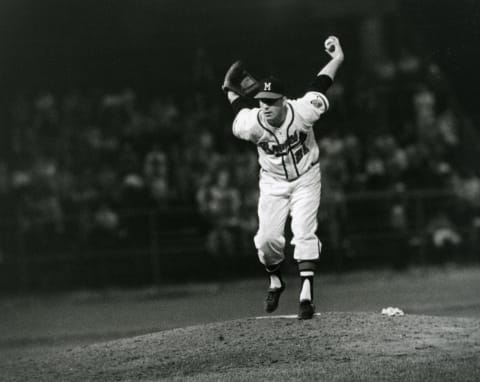
Braves all-time workhorse: Warren Spahn
5,046 innings
Like Feller, Spahn lost all or part of four seasons to World War II combat, underscoring the remarkability of his records. He returned in 1946 and in 1947 became a star, amassing 289.2 innings and a 2.23 ERA – both league bests – on the way to a 21-10 record. In 1948, he and Johnny Sain led Boston’s Braves to the franchise’s first National League championship in 34 seasons. In 1949 he rang up another 302 innings.
That was the way Spahn operated. Between 1947 and 1963, he only once fell below 250 innings of workload…and then only to 246 innings in 1955.
A dozen times between 1947 and 1963, he exceeded 20 wins, averaging 35 starts per season. He won the 1957 Cy Young Award in leading Milwaukee to the World Series victory over New York. He was 4-3 in six starts and two relief appearances across three World Series. In 1958, Spahn won the first and fourth games but lost game six 4-3 in 10 innings.
Particularly in the 1990s, the Braves produced a succession of pitchers who made some sort of run at Spahn but eventually gave up the chase. Tom Glavine left via free agency in 2002 with 3,408 innings, and John Smoltz followed in 2009 for Boston with 3,395.
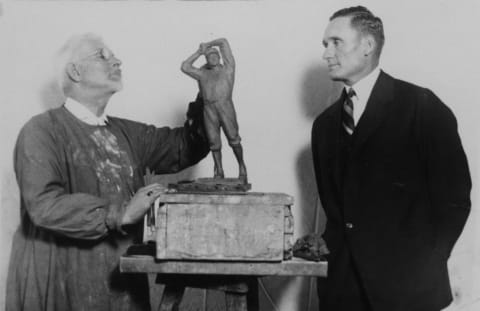
MN Twins (Washington Senators) all-time workhorse: Walter Johnson
5,914.1 innings
The all-time record holder in MLB history for innings pitched with a single team – and likely to continue to hold that distinction for the foreseeable millennia – is the long-time Senators ace and second-winningest pitcher in baseball history.
More from Call to the Pen
- Philadelphia Phillies, ready for a stretch run, bomb St. Louis Cardinals
- Philadelphia Phillies: The 4 players on the franchise’s Mount Rushmore
- Boston Red Sox fans should be upset over Mookie Betts’ comment
- Analyzing the Boston Red Sox trade for Dave Henderson and Spike Owen
- 2023 MLB postseason likely to have a strange look without Yankees, Red Sox, Cardinals
Signed by the Senators in 1907 out of an Idaho minor league, Johnson’s is probably the pre-eminent story of the value of scouting. He debuted that August and was an immediate sensation. Relying on little more than his blazing speed, he still topped 250 innings annually from 1908 through 1919, and topped 300 from 1910 through 1918. On six different occasions, he led the American League in victories. He also led in ERA five times, in starts four times, and in complete games six times. His 110 career shutouts is 20 more than any other pitcher in history.
This vignette perhaps sums up Johnson’s amazing durability better than any other. On Sept. 4, 1908, he shut out the New York Highlanders 3-0, allowing six hits. The next day, he shut out the Highlanders a second time, 6-0, this time allowing four hits. Two days later, he shut out the Highlanders a third time, this time pitching a two-hitter. That made three shutouts in four days on a total of just a dozen base hits – all, for the record, singles. (He did walk one batter and hit one other.)
Johnson spent his entire 21-season career with Washington, retiring at the end of the 1927 season. He left with a career 417-279 record and 2.17 ERA, having allowed 1,000 fewer hits than innings pitched.
Next. What might have been for Bob Friend. dark
Since then, the closest any franchise pitcher has come to approaching him was Jim Kaat, and he stopped at 3,014 innings, still nearly 3,000 short of Johnson. Among pitchers of recent vintage, Johan Santana got to 1,308. It goes without saying that if the Twins have somebody capable of eventually surpassing Johnson, that pitcher has not stepped forward yet.